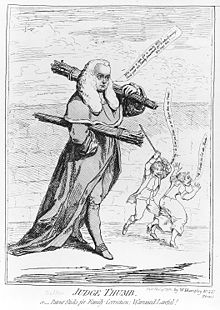Rule of thumb
|
Read other articles:

Questa voce sull'argomento stagioni delle società calcistiche italiane è solo un abbozzo. Contribuisci a migliorarla secondo le convenzioni di Wikipedia. Segui i suggerimenti del progetto di riferimento. Voce principale: Associazione Calcio Fanfulla 1874. Associazione Sportiva FanfullaStagione 1962-1963Sport calcio Squadra Fanfulla Allenatore Fausto Braga Presidente Ennio Paleari Serie C7° Maggiori presenzeCampionato: Vaglia (34) Miglior marcatoreCampionato: Spelta (11) 1961-1962 19…

Commune in Île-de-France, FranceHerblay-sur-SeineCommuneThe old village of Herblay, alongside the River Seine Coat of armsLocation (in red) within Paris inner and outer suburbsLocation of Herblay-sur-Seine Herblay-sur-SeineShow map of FranceHerblay-sur-SeineShow map of Île-de-France (region)Coordinates: 48°59′27″N 2°09′59″E / 48.9908°N 2.1664°E / 48.9908; 2.1664CountryFranceRegionÎle-de-FranceDepartmentVal-d'OiseArrondissementArgenteuilCantonHerblay-sur-Sei…

Election in Michigan Main article: 1940 United States presidential election 1940 United States presidential election in Michigan ← 1936 November 5, 1940 1944 → All 19 Michigan votes to the Electoral College Nominee Wendell Willkie Franklin D. Roosevelt Party Republican Democratic Home state New York New York Running mate Charles L. McNary Henry A. Wallace Electoral vote 19 0 Popular vote 1,039,917 1,032,991 Percentage 49.85% 49.52% County Results …

Gatehouse in Split, CroatiaGolden GateNative name Croatian: Zlatna vrataThe Golden Gate (Porta Aurea) May 2018TypeGatehouseLocationSplit, CroatiaCoordinates43°30′33″N 16°26′26″E / 43.50917°N 16.44056°E / 43.50917; 16.44056Built4th century ADBuilt byDiocletianArchitectural style(s)RomanLocation of Golden Gate in Croatia The Golden Gate (Croatian: Zlatna vrata, Latin: Porta Aurea), or the Northern Gate, is one of the four principal Roman gates into the stari gra…

American football player (born 1985) American football player Sam BakerSam Baker working with the USC TrojansNo. 72Position:Offensive tacklePersonal informationBorn: (1985-05-30) May 30, 1985 (age 38)Tustin, California, U.S.Height:6 ft 5 in (1.96 m)Weight:301 lb (137 kg)Career informationHigh school:TustinCollege:USC (2003–2007)NFL draft:2008 / Round: 1 / Pick: 21Career history Atlanta Falcons (2008–2014) Career highlights and awards 3× Firs…

Peta rencana Hokushin-ron yang menggambarkan rencana serangan ke Uni Soviet. Tanggal di gambar ini menunjukkan tanggal ketika Jepang memperoleh wilayah tersebut. Doktrin Ekspansi Utara (北進論code: ja is deprecated , Hokushin-ron atau Jalan Utara) adalah doktrin politik di Kekaisaran Jepang sebelum meletusnya Perang Dunia II yang menyatakan bahwa Manchuria dan Siberia adalah wilayah yang penting untuk ekspansi ekonomi dan wilayah Jepang. Pendukung doktrin ini kadang-kadang disebut Kelompok Se…

1974 local election in England, UK This article has multiple issues. Please help improve it or discuss these issues on the talk page. (Learn how and when to remove these template messages) This article needs to be updated. Please help update this article to reflect recent events or newly available information. (July 2019) This article relies largely or entirely on a single source. Relevant discussion may be found on the talk page. Please help improve this article by introducing citations to addi…

2016年美國總統選舉 ← 2012 2016年11月8日 2020 → 538個選舉人團席位獲勝需270票民意調查投票率55.7%[1][2] ▲ 0.8 % 获提名人 唐納·川普 希拉莉·克林頓 政党 共和黨 民主党 家鄉州 紐約州 紐約州 竞选搭档 迈克·彭斯 蒂姆·凱恩 选举人票 304[3][4][註 1] 227[5] 胜出州/省 30 + 緬-2 20 + DC 民選得票 62,984,828[6] 65,853,514[6] 得…

此條目可能包含不适用或被曲解的引用资料,部分内容的准确性无法被证實。 (2023年1月5日)请协助校核其中的错误以改善这篇条目。详情请参见条目的讨论页。 各国相关 主題列表 索引 国内生产总值 石油储量 国防预算 武装部队(军事) 官方语言 人口統計 人口密度 生育率 出生率 死亡率 自杀率 谋杀率 失业率 储蓄率 识字率 出口额 进口额 煤产量 发电量 监禁率 死刑 国债 外…

Guangzhou F.C. 2010 Football team seasonGuangzhou F.C. 2010Chairman Liu YongzhuoHead coach Lee Jang-Soo Li Chunman (in name)StadiumZengcheng StadiumCentury Lotus StadiumYuexiushan StadiumLeague One1stTop goalscorer Gao Lin (20 goals) Home colours Away colours ← 20092011 → The 2010 season is the 57th year in Guangzhou Football Club's existence, their 43rd season in the Chinese football league. The club was relegated to China League One in the fallout of …

此条目序言章节没有充分总结全文内容要点。 (2019年3月21日)请考虑扩充序言,清晰概述条目所有重點。请在条目的讨论页讨论此问题。 哈萨克斯坦總統哈薩克總統旗現任Қасым-Жомарт Кемелұлы Тоқаев卡瑟姆若马尔特·托卡耶夫自2019年3月20日在任任期7年首任努尔苏丹·纳扎尔巴耶夫设立1990年4月24日(哈薩克蘇維埃社會主義共和國總統) 哈萨克斯坦 哈萨克斯坦政府與�…

For the actual street that the station is located on, see Bergenline Avenue. Bergenline AvenueBergenline Avenue station entrance/exit in August 2009General informationLocationBergenline Avenue between 48th and 49th StreetsUnion City, New JerseyCoordinates40°46′55″N 74°01′19″W / 40.782077°N 74.02185°W / 40.782077; -74.02185Owned byNew Jersey TransitPlatforms1 island platformTracks2Connections NJ Transit Bus: 22, 84, 86, 89, 156, 159, 181ConstructionBicycle…

Серія AСезон 2013–14Чемпіони «Ювентус»Вибули «Ліворно»«Болонья»«Катанія»Ліга чемпіонів УЄФА «Ювентус»«Рома»«Наполі»Ліга Європи «Фіорентіна»«Інтернаціонале»«Торіно»Зіграно матчів 380Забито голів 1039 (2.73 за гру)Найкращий бомбардир Чіро Іммобіле(22 голи)Найбільша перем�…

British League of Nations mandate (1920–1948) This article is about the geopolitical entity. For the document granting Britain a mandate over both Palestine and the Emirate of Transjordan, see Mandate for Palestine. Palestine1920–1948 Flag Public Seal[1] Mandatory Palestine in 1946StatusMandate of the United KingdomCapitalJerusalemCommon languagesEnglish, Arabic, HebrewReligion Islam, Judaism, Christianity, Baháʼí Faith, Druze faithDemonym(s)PalestinianHigh Commissioner&…

Ruff degradation is a reaction used to shorten the open chain forms of monosaccharides.[1] It is functionally the reverse reaction of Kiliani-Fischer synthesis. In 1898, Otto Ruff published his work on the transformation of D-Glucose to D-Arabinose later called the Ruff degradation. In this reaction, D-Glucose is converted to D-Arabinose. In this reaction, the terminal aldehyde group is converted to a carboxylic acid group, using selective oxidation of the aldehyde using Bromine water an…

Bishop of Antioch from 260 to 268 This article includes a list of general references, but it lacks sufficient corresponding inline citations. Please help to improve this article by introducing more precise citations. (February 2008) (Learn how and when to remove this message) Paul of Samosata preaches from the pulpit. Paul of Samosata (Greek: Παῦλος ὁ Σαμοσατεύς, lived from 200 to 275 AD) was Bishop of Antioch from 260 to 268 and the originator of the Paulianist heresy named a…

Terence James CookePelayan TuhanKardinal, Uskup Agung New YorkGerejaGereja Katolik RomaTakhtaNew YorkPenunjukan2 Maret 1968Awal masa jabatan4 April 1968Masa jabatan berakhir6 Oktober 1983PendahuluFrancis SpellmanPenerusJohn Joseph O'ConnorImamatTahbisan imam1 Desember 1945oleh Francis SpellmanTahbisan uskup13 Desember 1965oleh Francis SpellmanPelantikan kardinal28 April 1969oleh Paus Paulus VIPeringkatKardinal-ImamInformasi pribadiLahir(1921-03-01)1 Maret 1921Manhattan, New York City, …

Czech painter and graphic artist Václav BrožíkVáclav BrožíkBorn(1851-03-06)6 March 1851Třemošná, Bohemia, Austrian Empire (now Czech Republic)Died15 April 1901(1901-04-15) (aged 50)Paris, FranceNationalityCzechEducationAcademy of Fine Arts in PragueKnown forPaintingNotable workJan Hus before the Council of Constance (1883)Tu Felix Austria Nube (1886)MovementAcademicismSpouseHermine SedelmayerAwardsGold medal winner at the Salon (1878)Legion of Honour (1884)Ennobled by Emperor …

Ada usul agar artikel ini digabungkan ke Jalan Tol Lingkar Luar Jakarta. (Diskusikan) Jalan Tol Lingkar Luar Jakarta W2Panjang7,87 kmDibangun2013-2014PengelolaPT Marga Lingkar Jakarta (MLJ) Jalan Tol Lingkar Luar Jakarta W2 Utara adalah jalan tol lanjutan Jalan Tol Lingkar Luar Jakarta W1 yang menghubungkan kawasan Kembangan dengan kawasan Ulujami. Panjang jalan tol ini adalah 7,87 km. Dikelola oleh PT. MLJ. Nantinya jalan tol ini akan beroperasi menjadi 2 bagian yaitu Jalan Tol Lingkar Luar Jak…

This article relies excessively on references to primary sources. Please improve this article by adding secondary or tertiary sources. Find sources: Sergey Zasimovich – news · newspapers · books · scholar · JSTOR (May 2024) (Learn how and when to remove this message)Kazakhstani high jumper Sergey Sergeyevich Zasimovich (Russian: Серге́й Серге́евич Засимович; born 11 March 1986) is a Kazakhstani high jumper. Zasimovich was born in…
